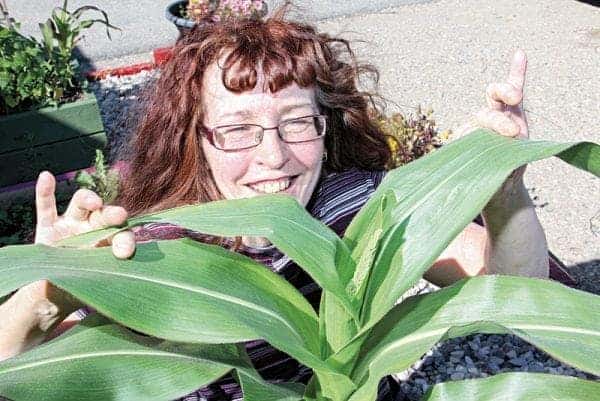A gardener's accomplishment is drawing attention on social media and prompting questions about climate change.

Though Linda Duford has been growing corn for 35 years, she had yet to see an actual cob develop on the plants – until now.
"Ever since I've had gardens, I've always grown corn because I like how it looks. I like that it grows fast. It's got the beautiful leaves," she said. "And I never really expected to get anything because nobody I ever knew got a corn up here.... And then this year with my tallest one a few weeks ago, I looked and there was the makings of a corn on the cob. I just about fainted."
Duford said she has been growing corn in Edmonton, High Level, Alta., and for about the past 10 years in Hay River.
This year, she has about a dozen corn plants in front of her home, but only one has developed a couple of cobs.
That has left her happy, very surprised and even a bit shocked.
As of last week, the cobs had not yet grown any kernels but that hasn't diminished the attention she's received.
"After I announced it on my Facebook page, because I was so excited, I had a lot of serious gardeners give me feedback that said corn is not something that is normally grown up here, because temperatures have to reach a certain degree over a prolonged period of time," she said. "So I guess this is the problem up here. We might get the hotter temperatures, but we don't get it long enough."
One person asked if she needed help with her harvest.
Duford is wondering if the cob on the corn actually means something.
"Maybe this is a sign of climate change," she said, noting it was unusually warm in Hay River this summer and she even planted the corn later than usual.
Jackie Milne, president of the Northern Farm Training Institute (NFTI), said that the growth of corn is very much connected to the climate.
"Normally, our summers have always been traditionally too cold for corn," she said. "So it's a sign that, if you can grow corn, it's a very warm season."
Milne has heard stories of corn growing before in Hay River.
"They'll plant corn and then they'll get a few cobs," she said. "We kind of are right on the edge of its range."
It's like growing a watermelon, she added. "They're hard to grow, too, up here because they like it hot."
Milne also wondered if Duford's corn plant might be another small indication of climate change.
"There are these little changes that are starting to happen that are showing up in different ways," she said.
Corn is not grown at the NFTI farm campus.
"We concentrate on other crops," said Milne. "It is sort of like a little novelty, specialty kind of thing. It takes a lot of care and love, which Linda clearly gave it. It was that secret ingredient. She loved it so much. That's why it grew."